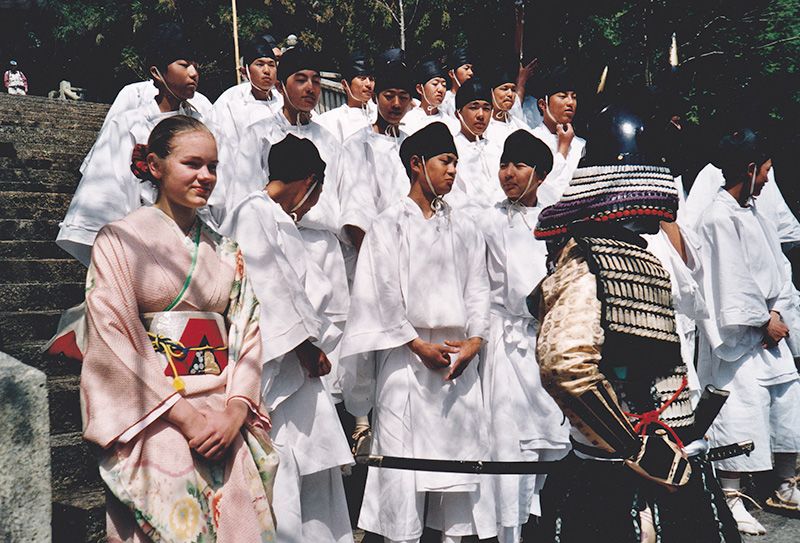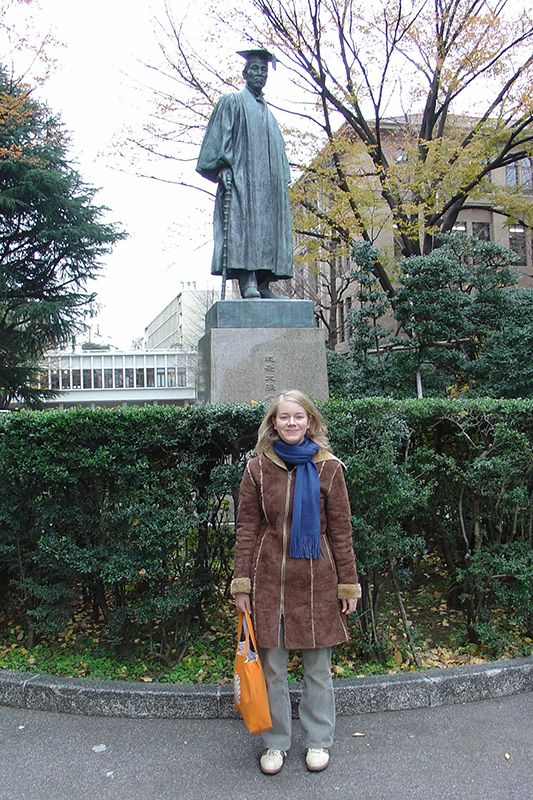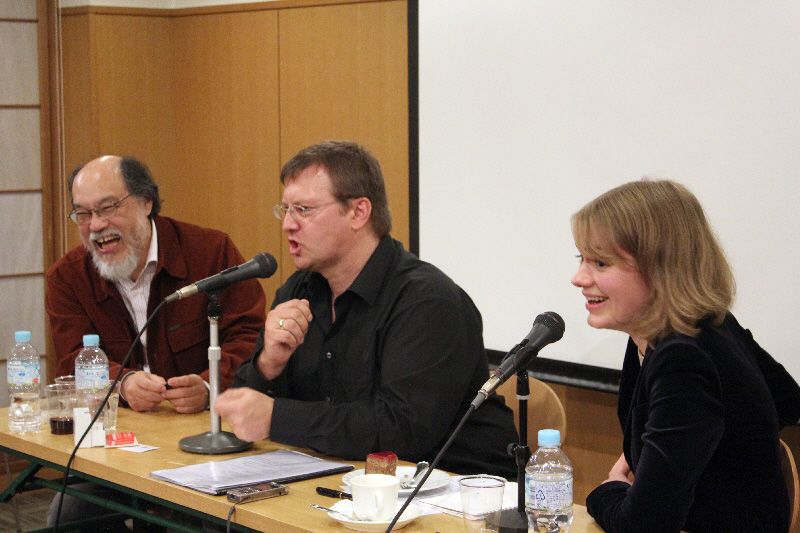
How I Learned Japanese: The Freedom of the Non-Native Speaker
Society Culture- English
- 日本語
- 简体字
- 繁體字
- Français
- Español
- العربية
- Русский
I was in my first years of elementary school when I encountered kanji for the first time. I was taken by an aunt to an ethnological museum, and there among the exhibits was a scroll painted with the Chinese character for sheep: 羊. I can still remember vividly the impression it made on me. Children’s picture books and other sources had already inspired a degree of interest in Japan by this stage, but after this direct encounter I became totally obsessed with kanji. This was the start of my “Japanese career.”
Fantasy Asia and Invented “Kanji”
One’s elementary school years are a time of imagination and make-believe. Of course I knew nothing of Japanese grammar. But whenever it was time to draw in class, I would always concoct fantasy pictures of what I imagined were Asian scenes, decorated with “kanji” of my own invention—and the character for sheep that I remembered from my visit to the museum. I was drawn to the beauty of this new way of writing, so different from the German alphabet, which struck my childish mind as unnecessarily longwinded and cumbersome. I loved the idea of each symbol conveying a single concept, or a whole world. And I loved how quickly the characters could be written. (Sometimes I tried writing the character for sheep and spelling out the word out in German and timing myself to see which took longer.) The fact that it was possible to write a whole word in such a small space impressed me as extremely practical and rational. This might sound like a typically “German” way of thinking about things. But I had made up my mind: One day I would learn how to write these wonderful characters myself.
If it was just a question of learning kanji, then of course Chinese, where the characters originally come from, would have been the obvious choice. But for some reason I felt I had some kind of special affinity for Japan. When I was 14 or 15 I decided to enroll in an introductory Japanese class that was being offered at a local community college. To my disappointment, however, I soon found out that the curriculum was based entirely on roman script. And the lessons leapt from “konnichiwa” to intermediate and advanced grammar—before I knew what was happening, I was lost in a discussion of the intricacies of the passive voice. I was not much wiser when the course came to an end.
The next step I took was to join a “Japanese club” for high school students that was advertised in the local newspaper in Kiel. This time, things were different. The class started with the hiragana and katakana syllabaries and then moved on to kanji as well. The class was already fairly advanced by the time I joined, but I was determined to learn how to write “real” Japanese, and in my desperation to catch up, I memorized the whole of the basic grammar in a single day. I made a series of hiragana flashcards, and by the time I had run though the letters in order several times, I was ready to fully take part in the class. Sometimes it helps to really throw yourself into something!
The Exchange Diary I Wrote With My Japanese Friend
In 1999, when I was 16, I came to Japan on my own and spent ten months at a high school in the city of Himeji in Hyōgo Prefecture. At the time, my Japanese was at a level where I could just about say, “I buy an apple.” When I heard people speaking Japanese around me, all I could do was seize on the few words I recognized and reconstruct in my mind an image of what they must be saying, based on context. In this way, I could just about grasp the dim outlines of what was being said. But that was all.
 I took part in all kinds of local events during my year as a high school student in Himeji.
I took part in all kinds of local events during my year as a high school student in Himeji.
If I tried to construct a grammatically correct Japanese sentence in my head, by the time I opened my mouth to speak it was already too late. The moment had passed. That’s how it is with real conversation. The obsession with not making a mistake, with speaking accurately and correctly, was holding me back.
My biggest supports during those days were my friends at school and television. At school, I became close friends with two classmates in particular. I started to write an exchange diary with one of them. We would take it in turns to write entries in English and Japanese, correcting each other’s mistakes as we wrote down our thoughts and feelings and introduced each other to things we wanted to share. For someone like me, who struggled to keep up with the speed of normal conversation, the diary was an ideal opportunity to write in Japanese at my own pace. Slowly but surely, my Japanese began to improve.
When I was a student in Himeji, the Internet wasn’t as much a part of everyday life as it is now, and my main tools for learning Japanese were textbooks and dictionaries. In those days you couldn’t immediately look up any unfamiliar words online the way you can now. I had to observe as objectively as possible how people were using the words and phrases I heard for the first time. By doing this, I managed to teach myself to understand and use these expressions myself. On TV, the on-screen text “subtitles” that are such a characteristic of Japanese television were a great help, whether I was watching the news or one of the light entertainment programs. Watching television turned out to be a great way of learning how a word was pronounced and how it was written. Nowadays there are probably more effective methods of study, but I don’t think my efforts back then were totally wasted. If nothing else, they helped me develop my listening ability and taught me perseverance.
The Pleasure of Blogging in Japanese
After returning to Germany from Himeji, I continued my Japanese studies at the University of Bonn. I spent my third year on a Japanese language program at Waseda University in Tokyo.
 In front of the sculpture of Ōkuma Shigenobu at Waseda University
In front of the sculpture of Ōkuma Shigenobu at Waseda University
Most of the classes I took during my studies at Waseda focused on mastering Japanese. But of course, “mastering” the grammar is only the beginning. It is after leaving the classroom that the student runs into a wall. A gap exists between the grammar you learn in the classroom and the living language as it is actually spoken. In Japanese, the situation is made even more complicated by the fact that the colloquial language exists alongside the more rarified “polite language” known as keigo. I remember being puzzled to find that many of the patterns and locutions I had been told to avoid as “ungrammatical” were in fact in widespread use in ordinary speech. How to overcome this discrepancy between theory and reality? Online blogs were just starting to enter the mainstream at this time. For me, it was the experience of writing my own blog that opened the door to true fluency.
I started writing my blog in German at first, as a way of giving my family and friends back home an idea of the life I was living in Japan. But when some of my Japanese friends told me they’d be interested in reading my blog too, I decided to take the plunge and try my hand at writing in Japanese as well. This was a big turning point. Writing a blog was different from doing Japanese homework for class. Here, the most important thing was not to be absolutely grammatically correct, but to write something in Japanese that would be interesting to read. It allowed me to use the language as I experienced it for myself. I was free to try new things and see how they went. And I was no longer writing in a vacuum—instead, by communicating with people around me, I was able to get feedback on what I was writing, and make sure that it made sense. As a result, I gradually developed a sense for the kind of Japanese that I could use for my own purposes.
 I acted as moderator and interpreter when Austrian writer Andreas Gruber visited Japan in March 2013 to mark the first Japanese translation of his novel “Rachesommer” (Summer of Revenge). On the left is Sakayori Shin’ichi, a Japanese translator of German literature.
I acted as moderator and interpreter when Austrian writer Andreas Gruber visited Japan in March 2013 to mark the first Japanese translation of his novel “Rachesommer” (Summer of Revenge). On the left is Sakayori Shin’ichi, a Japanese translator of German literature.
I wrote my blog for five years. It changed my life massively, not just by improving my Japanese, but by allowing me to discover something more fundamental—the joy of writing. Japanese has lots of words to express emotional concepts that we don’t have in German. For some reason, I feel these expressions match my personality. My sense for Japanese might not be quite the same as a Japanese person’s. But conversely, I have come to feel that as a foreign-language user of the language, I am free to use Japanese in a free way that might not be possible for a native speaker.
(Originally written in Japanese on May 30, 2013.)
Germany NHK Japanese Marei Mentlein mystery magazine Kiel Bonn Universität